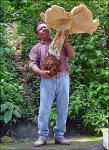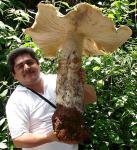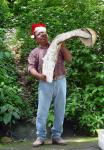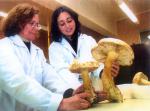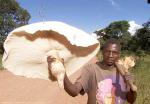
45 lb edibles?!
#1

Posted 11 April 2008 - 02:19 PM
Supposedly they're from around Chiapas Mexico, near the border of Guatemala..... But I haven't been able to find the scientist/organization/university's name(s).
#2

Posted 11 April 2008 - 05:28 PM
#3

Posted 11 April 2008 - 05:34 PM
#4

Posted 11 April 2008 - 06:26 PM
that shit was hilarious. :pirate:
#5

Posted 11 April 2008 - 08:21 PM

Badass :headbang:
#6

Posted 11 April 2008 - 09:35 PM
#7

Posted 11 April 2008 - 11:35 PM
#8

Posted 12 April 2008 - 01:33 PM
I managed to find a little more info,
These pics were taken and the shroom found by scientists according to this article.
An anaylsis for identification of toxic compounds and suitability for eating was done and the results shown by T. Stijve in the swiss journal Mededelingen, 2004 (No. 3) 93-94...... I've also got his mailing address.
He says they're good eatin! This was a pretty recent paper however, and lots of other sources still say that noone knows whether or not they're edible.
A live culture of this shroom is easily obtained workman, assuming you can throw down some $$$ I know you're probably aware of this but PM me if you'd like a few pointers as to where one could be found.
#10

Posted 12 April 2008 - 02:25 PM
#11

Posted 12 April 2008 - 08:19 PM
#12

Posted 23 January 2009 - 12:42 PM
Does anyone have some information or material of how to grow/cultivate this shroom ?
Sorry my bad english, i´m from Santa Catarina, Brazil, close to Parana.
Thanks
#13

Posted 08 February 2009 - 12:04 PM
#14

Posted 08 February 2009 - 03:40 PM
I've seen these pics flying around the net and wondered if anyone has anymore info as to specifically where they came from and who found them..... I'd love to contact these fellas and get a sample of this giant edible if possible!
Supposedly they're from around Chiapas Mexico, near the border of Guatemala..... But I haven't been able to find the scientist/organization/university's name(s).
There are even bigger shrooms than those that are culivated by Termites in Africa and other regions of the world know as Termitomyces titanicus.
Also There is a paper in my files by Dr. Tjakko Stijve on the cultivation of Macrocybe titans.
The photo directly below of the titans variety grown in vitro is by Dr. Tjakko Stijve from 2004 of the same mushroom you poted an image of..
http://mycotopia.net...=1&d=1234125134
A diferent paper on the termite shrooms. One colony in Mexico is also known to cultivate a magic species as wella s the edible variety.
Termites and Termitomyces sp.
an Insect – Fungus Symbiosis.
D. W. Gover
Termites (Class Insecta, Order Isoptera), are found mostly in the
tropics, some in temperate zones and very few in the cooler climates. With
about 2600 species worldwide they are probably the dominant organism in
tropical forest environments. One subfamily, the Macrotermitinae Termites
found in the Old World and parts of Asia consume plant material, construct
“combs” with their excreted ‘psuedofaeces’ and inoculated with the spores of
an exosymbiont fungus, Termitomyces species, the fungus grows on the
combs and produces a nutritious fungal compost containing a variety of
energetically expensive nitrogen compounds, that is consumed by the
termites. The fungal comb is a kind of extracorporeal digester to which the
termites have ‘outsourced’ cellulose and lignin digestion. The fungus-enriched
food allows the termite colony to mobilise energy at faster rates and are not
limited by the bacterial endosymbionts of most other species of termite. A
mature colony will have a total of about 40 kg of fungal combs, each comb
located in a semi-enclosed gallery around the periphery of the aboveground
mound nest and when the rains arrive the fungus Termitomyces produces
mushrooms that penetrate the nest and emerge above ground. The edible
and nutritious mushrooms are highly prized as a delicacy and contribute to the
local economy.
There are more than 60 Termitomyces taxa described, but reliably only
18 species, collected mainly from West Africa, are reasonably well known, the
rest are either synonyms or badly described and difficult to identify. A genus,
Sinotermitomyces has been reported from China, but species are difficult to
classify. Characteristically, Termitomyces has pinkish spores, a cap and stipe
at the top of a long ‘pseudorhiza’ that arises from the comb and the cap has a
‘perforatorium’ or ‘umbo’ that assists the mushroom to penetrate the hard
ground and there is a termite association. Recent molecular work supports the
placement of Termitomyces in the Tricholomataceae.
Wild fungi parasitise the rich store of food in the nest but the evolution
of fungistats and diligent weeding ensures that only Termitomyces grows.
Abandoned nests are quickly taken over by other fungi, particularly Xylaria
species.
Macrotermitinae Termites may be considered as small but remarkable
‘ecological engineers’ that have developed a set of successful agricultural
strategies to ensure Termitomyces alone ‘value-adds’ their relatively lowgrade
plant material diet. Success in ensured by propagating fungal clones in
huge monocultures, evolving fungistats that appear to co-evolve with
pathogens and being intensely vigilant in monitoring the fungal combs to
eradicate resistant pathogen mutants before an epidemiological outbreak. Of
course, the fungus benefits in having a comfortable home, is well nourished
and a variety of species are cultivated that are protected from wild fungal
competitors. Perhaps, one measure of the termite’s success is that they grow
one of the world’s largest mushrooms, Termitomyces titanicus. While T.
microcarpus, one of the smallest of the genus has a cap diameter of 2 cm; the
cap of T. titanicus is known to commonly reach 1 metre in diameter!
A photo of a small termitocyces
http://mycotopia.net...=1&d=1234125272
mjshroomer
#15

Posted 20 February 2009 - 02:12 AM
#16

Posted 20 February 2009 - 02:03 PM
One colony in Mexico is also known to cultivate a magic species as wella s the edible variety.
Which magic species do the termites cultivate?
#17

Posted 20 February 2009 - 02:49 PM
Giant 56-Pound Mushroom Found In Missouri
Fungus Is Likely North America's Largest Ever Found
POSTED: Thursday, October 27, 2005
UPDATED: 2:09 pm EDT October 27, 2005
A 56-pound mushroom found on a tree in Missouri is likely the largest ever found in North America, according to a report.
Ty Whitmore found the giant fungus in Maysville, near Kansas City this week."I was out there cutting down some trees and I noticed something out about a 100 yards in front of me," Whitmore said. "I was wondering what it was. And ah, I end up getting curious and walking down the creek and I was like, 'Oh my God, it's like a huge mushroom.'"After showing the 3-foot wide mushroom, professors from around the country have told him it is the largest ever found on the continent."I took it in and weighed it and it ended up weighing like 56 pounds and I thought, well this is pretty big," Whitmore said. "So, I started calling around and the next thing I know I got professors from Florida calling me and from Wisconsin telling me this is like a world-record mushroom."He said someone in Wisconsin offered him $50,000 for it.Watch Local 6 News for more on this story.



